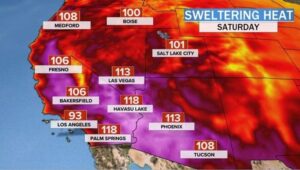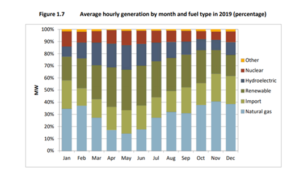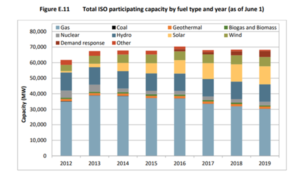10/6/2020 Update: The California Independent System Operator (CAISO), California Public Utilities Commission (CPUC), and California Energy Commission (CEC) issued a Preliminary Root Cause Analysis of the August 2020 heat wave and rotating outages. Press release.
There have been many questions about why the state experienced power emergencies in August and September. We have compiled the following information to share relevant background information and what is known so far. While all variables have not been identified, the extreme heat storm throughout the west was a major factor. There is an ongoing investigation among state energy regulators and the grid operator, and as more information becomes available we will continue to share what we learn.
Thank you to all consumers who did their part to conserve energy during the Flex Alert hours to help avoid rolling outages.
1) Why were ‘rotating outages’ required on the California grid on August 14th/15th?
 A historic heat storm spanning the American West resulted in high electric demand and forced outages at many power plants. As a result, demand exceeded available supply in the early evening hours. To maintain a balance of electric supply and demand on the grid, rotating outages were implemented for some customers in California. This last occurred in 2001.
A historic heat storm spanning the American West resulted in high electric demand and forced outages at many power plants. As a result, demand exceeded available supply in the early evening hours. To maintain a balance of electric supply and demand on the grid, rotating outages were implemented for some customers in California. This last occurred in 2001.
2) Why wasn’t there enough electricity available during the evening hours of August 14 & 15?
California’s electric reliability needs are planned around the range of weather conditions historically observed during the summer. The region-wide heat storm experienced on August 14-15 was an extreme event and resulted in near-record demand for electricity. As solar power on the grid was ramping down in the evening, a number of natural gas power plants also went offline. It was not possible to obtain sufficient back-up power from nearby states as planned, due to the geographic extent of the heat and restrictions on electricity transport via transmission lines. Further, the state was not able to use hydro facilities to help fill the deficit due to lower than average water supplies this year.
3) Why do high temperatures result in high levels of electricity usage?
Overall electric use on the grid rises significantly during heat storms, due mainly to increased demand for air conditioning.
4) Was ‘renewable energy’ to blame for the outages?
The president of California’s power grid operator, Stephen Berberich, has dismissed these types of criticisms, saying renewable energy wasn’t to blame for the outages. The real problem, he said, was a statewide failure to assemble the right mix of energy sources for the completely predictable situation of energy demand staying high after the sun goes down.
5) Why should we continue to ‘electrify’ cars and buildings?
Since the early 1970s carbon dioxide in the earth’s atmosphere is up by more than 25%, and California summer temperatures are up by an average of 2.5 degrees Fahrenheit. If these trends continue, Santa Clara valley is likely to experience 10 to 20 additional extreme heat event days by the year 2050, with increased health and wildfire risks. Fossil fuel use in vehicles and buildings produce more than 70% of greenhouse gas emissions in Silicon Valley. To address climate change we must reduce GHG emissions by switching to clean electricity and reducing fossil fuel use.
6) Where does electricity on the California grid come from?
 In 2019, 34% of the electricity on the California grid was generated from natural gas-fired power plants, 15% from large hydro, 12% from solar, 10% from wind, 10% from geothermal and other renewables, 9% from nuclear, and 10% from other or unspecified sources. Approximately 29% of this electricity used in California was imported from neighboring states.
In 2019, 34% of the electricity on the California grid was generated from natural gas-fired power plants, 15% from large hydro, 12% from solar, 10% from wind, 10% from geothermal and other renewables, 9% from nuclear, and 10% from other or unspecified sources. Approximately 29% of this electricity used in California was imported from neighboring states.
7) How is the electricity supply changing in California?
 California’s goal to source 100% of its electricity from renewable sources by 2045 is driving major changes in the state’s electricity supply. While natural gas power plants are still the largest single source of electricity on the grid, they are being steadily replaced by renewable sources such as solar, wind, geothermal and biomass.
California’s goal to source 100% of its electricity from renewable sources by 2045 is driving major changes in the state’s electricity supply. While natural gas power plants are still the largest single source of electricity on the grid, they are being steadily replaced by renewable sources such as solar, wind, geothermal and biomass.
8) With increases in renewable energy, is the California grid becoming more difficult to manage?
Renewable energy plants are more numerous and widely distributed than traditional fossil-fuel power plants. In addition, sources such as solar and wind are ‘intermittent’, as the sun doesn’t always shine and the wind doesn’t always blow. Energy provided from these resources is forecasted and planned for by day and by hour, and closely monitored by grid managers.
9) How do grid managers and utilities make sure there’s enough electricity available to meet large increases in demand?
Regulatory agencies and utilities perform forecasting and planning exercises to ensure there is enough capacity to meet peak electricity demand. Utilities are required to procure enough energy generating capacity (known as Resource Adequacy) to supply 115% of their forecasted peak demand – so that additional power plant capacity is ‘standing by’ if needed. Resource Adequacy requirements are being re-evaluated, to address changing energy use patterns and a growing shift in peak demand to the early evening hours when solar energy ramps down.
10) When extra electricity is needed, where does it usually come from?
Since the California grid is interconnected to other states throughout the west, it has the ability to import and export electricity. In 2019, California imported about 29% of its power from neighboring states in the Pacific Northwest and Southwest. When neighboring states face their own shortages, as during the recent heat storm, they are not able to export as much electricity to California and as a result customers are asked to reduce energy consumption to match supply.
11) What was done to mitigate the shortages seen on August 14 & 15?
California residents played a major role in mitigating the shortage, by responding to the ‘flex alert’ issued by the California Independent System Operator (CAISO) to conserve energy between the peak hours of 3 p.m. and 9 p.m. Large data center customers in Silicon Valley disconnected from the main power grid and used backup generators. And in Southern California, the US Navy disconnected their ships from the power grid. To bolster supply, the CAISO procured additional electricity within the state from plants that had not been in service, and from municipal utilities.
12) In the future, what needs to be done to assure that electricity supplies will be reliable as additional renewables are added to the grid?
- Pair renewables like solar and wind with energy storage so that power produced in the middle of the day can be used during peak evening hours
- Add renewable sources such as geothermal and biomass that can generate electricity on a 24×7 basis
- Expand stand-alone energy storage directly charged from and discharged to the grid
- Link efficient all-electric buildings and vehicles to the grid, to effectively respond to dynamic electricity supply conditions
- Integrate grid operators on a region-wide basis to effectively plan and balance supply and demand across states
- Maintain sufficient back-up generating capacity from traditional natural gas power plants as the grid transitions to renewables
References
Sweltering heat wave bakes the western United States, CBS News, August 14, 2020
2019 Annual Report on Market Issues & Performance, CAISO, June 2020
2019 Total System Electric Generation, CEC
2020 Summer Loads and Resources Assessment, CAISO, May 15, 2020
Observed Impacts of Anthropogenic Climate Change on Wildfire in California, AGU, July 15, 2019
Overview of Climate Change In Santa Clara County, Silicon Valley 2.0
Here’s how California can keep the lights on while meeting its clean energy goals, Los Angeles Times, August 19, 2020



